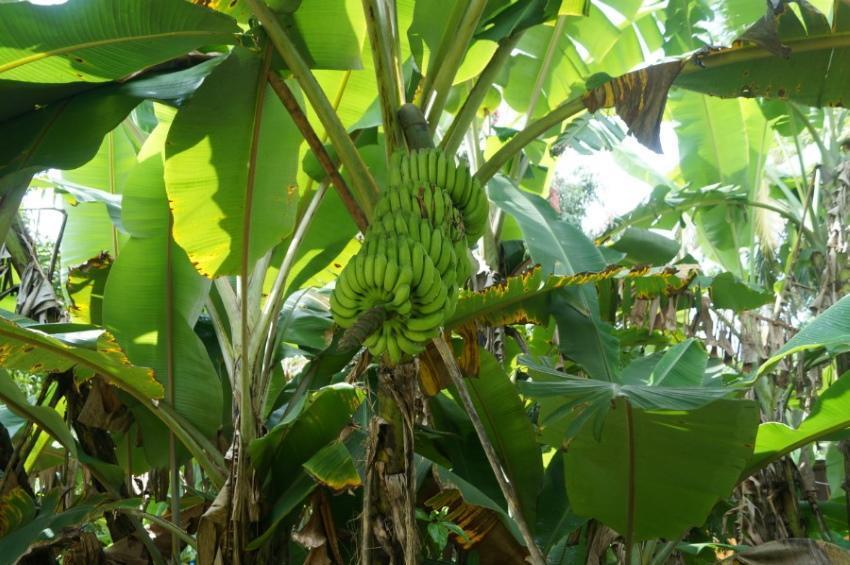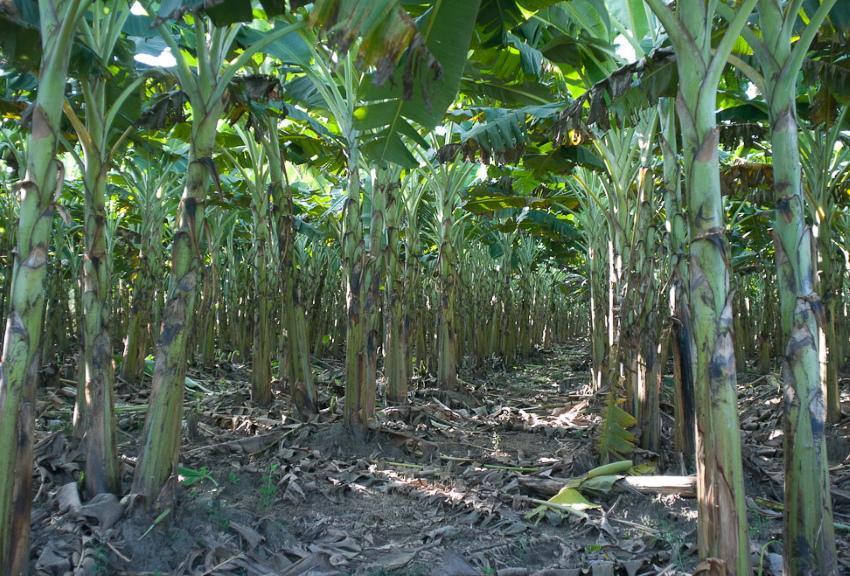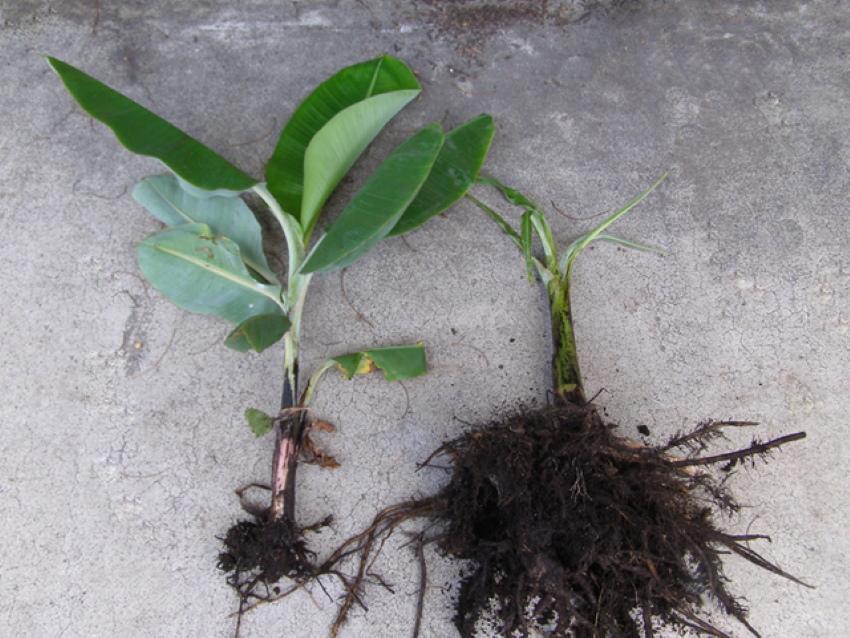How bananas grow - features of growth and fruiting of "overseas fruits"
 Almost all of us love aromatic and sweet long fruits, but few people know how bananas grow. Have you heard the expression "banana grove or plantation"? The brain immediately involuntarily draws us a picture with spreading palms and hanging yellow clusters. In fact, it would be more correct to call such plantings a giant unmown lawn. It would seem that an exotic plant can have in common with a grass, but you cannot argue with botany. And this science has long proved that bananas are not palms or even shrubs.
Almost all of us love aromatic and sweet long fruits, but few people know how bananas grow. Have you heard the expression "banana grove or plantation"? The brain immediately involuntarily draws us a picture with spreading palms and hanging yellow clusters. In fact, it would be more correct to call such plantings a giant unmown lawn. It would seem that an exotic plant can have in common with a grass, but you cannot argue with botany. And this science has long proved that bananas are not palms or even shrubs.
How bananas grow - botanical characteristics

Root system

The structure of the roots is characteristic of a group of herbaceous plants. Bananas have one main root, from which numerous fibrous roots radiate to the sides. They are responsible for the nutrition of the plant, extracting moisture and nutrients from the soil. Over time, the rhizome actively grows in a horizontal direction, moving away from the central root to the side up to 5 m. At the same time, it forms knots-processes that can be cut off and used for reproduction. And given that the roots are buried up to 1.5 m, bananas do not suffer from a moisture deficit.
Aerial part (trunk and leaves)
 Since a banana is a herb, it cannot have a trunk as such. What we mistake for the trunk of a palm tree is a fleshy and multi-layered false stem. It consists of young leaves, twisted in a cylinder and growing in a spiral. Each subsequent leaf appears directly from the center of the false stem. And the extreme plates gradually unfold and then die off. This is how the banana acquires a "palm shape": the stem is exposed, stretched out, and the foliage remains only at the top of the plant. The total height of such grass can reach 9 m, and there are also giant species up to 12 m in height.
Since a banana is a herb, it cannot have a trunk as such. What we mistake for the trunk of a palm tree is a fleshy and multi-layered false stem. It consists of young leaves, twisted in a cylinder and growing in a spiral. Each subsequent leaf appears directly from the center of the false stem. And the extreme plates gradually unfold and then die off. This is how the banana acquires a "palm shape": the stem is exposed, stretched out, and the foliage remains only at the top of the plant. The total height of such grass can reach 9 m, and there are also giant species up to 12 m in height.
Bananas are the second tallest herb in the world after bamboo, which also belongs to herbaceous plants.
The leaves themselves are not inferior in size to palm branches. With a length of almost 3 m and a width of up to 60 cm, they also grow quickly. In warm climates, a new leaf appears and fully unfolds in just 7 days. With a lack of heat, this process is delayed for almost a month.
 Most often, the leaves are colored deep green. But there are varieties with a double-sided color: with a green top and a dark red bottom. Bananas with green leaves painted with a crimson pattern look beautiful. The lower part of the leaf plate is rigid, and in the middle there is a thick central vein. Many small veins diverge from it.
Most often, the leaves are colored deep green. But there are varieties with a double-sided color: with a green top and a dark red bottom. Bananas with green leaves painted with a crimson pattern look beautiful. The lower part of the leaf plate is rigid, and in the middle there is a thick central vein. Many small veins diverge from it.
An unpredictable tropical climate with strong winds is not capable of much harm to the huge grass. Leaves with longitudinal veins are simply torn to pieces along them, but the plants themselves do not break.
Inflorescences
 When the banana grass completes its growth, a long peduncle grows from the center of the same herbaceous pseudostem. At its tip, a huge flower opens in the form of a purple bud. It is on it that the real flowers are located, which will give a harvest in the future.
When the banana grass completes its growth, a long peduncle grows from the center of the same herbaceous pseudostem. At its tip, a huge flower opens in the form of a purple bud. It is on it that the real flowers are located, which will give a harvest in the future.
There are a lot of them, and they are arranged in tiers in a strictly defined order:
- at the top, at the base of this purple bud - female flowers, the largest;
- behind them - bisexual and sterile flowers, already slightly smaller in size;
- and the lowest and smallest are male flowers.
All flowers have a tubular irregular shape, 3 sepals and petals and 6 stamens. Moreover, one of them is underdeveloped, without pollen. On the rest, there is a lot of it, up to 0.5 g each. Flower tiers form clusters of 2 dozen flowers. They are arranged radially and grow in small clusters. Each tier is covered with fleshy foliage. So, contrary to popular belief, bananas do not grow on a palm tree, but still on the grass, only very tall and powerful.
Wild bananas bloom at night or early in the morning. Male flowers are the first to bloom and immediately crumble.
Female flowers help to pollinate insects, birds and even animals. At night, bats are busy with this, and during the day - butterflies, bees, sunbirds and tupai.
Fruit
 Bananas yield crops only on the “female tier”. After pollination, many fruits are set there in the form of a young month. They can be triangular, curved, and nearly straight. But in general, the oblong shape is preserved in all varieties. At first, the fruits are green, as they ripen, they turn yellow or red. The sizes of bananas also depend on the specific variety. The minimum length of the fruit can be 3 cm, and the maximum - up to 40 cm. The overall thickness is about 5 cm or slightly more. In one seed, up to 300 bananas can ripen, and its total weight reaches 60 kg.
Bananas yield crops only on the “female tier”. After pollination, many fruits are set there in the form of a young month. They can be triangular, curved, and nearly straight. But in general, the oblong shape is preserved in all varieties. At first, the fruits are green, as they ripen, they turn yellow or red. The sizes of bananas also depend on the specific variety. The minimum length of the fruit can be 3 cm, and the maximum - up to 40 cm. The overall thickness is about 5 cm or slightly more. In one seed, up to 300 bananas can ripen, and its total weight reaches 60 kg.
Due to the force of gravity, the banana bunches grow downward. But under the influence of hormones, one of the axes can change its direction and rush up. This is due to such a biological phenomenon of the banana as negative geotropism. It manifests itself in the fact that the grass grows in the opposite direction to gravity.
And what is interesting is that the banana fruit is not even a fruit at all, as we used to think. From a botanical point of view, it is a berry with a delicious pulp. When green, it is firm and sticky, but ripe bananas become very sweet, soft and juicy. In the pulp of wild fruits there are a lot of dark, dense, round seeds. The cultivated varieties are mostly sterile.
How bananas grow - features of the growing season
 Banana cultivation is possible only in a warm tropical climate, where even at night the temperature does not drop below 22 ° C. The critical values for the plant are 10 ° C of heat, at which the grass dies. But the deceleration of growth processes begins to occur already at 16 ° C. The timing of the appearance and unfolding of leaves is extended by 3 times. This means that both flowering and fruiting are postponed.
Banana cultivation is possible only in a warm tropical climate, where even at night the temperature does not drop below 22 ° C. The critical values for the plant are 10 ° C of heat, at which the grass dies. But the deceleration of growth processes begins to occur already at 16 ° C. The timing of the appearance and unfolding of leaves is extended by 3 times. This means that both flowering and fruiting are postponed.
Although the crop can withstand drought for 3 months, it needs moisture to plant. Therefore, the landing is carried out during the rainy season. In general, bananas need at least 100 mm of monthly rainfall for normal growth and fruiting. Before the coming cold snap, plantations are prudently flooded or fumigated with smoke. This reduces the risk of plant destruction.
In nature, bananas reproduce vegetatively using seeds. Inflorescences are pollinated by birds and insects. The seeds fall into the ground, where they then sprout after about 2 months. However, wild bananas are not the sweet yellow berries we are used to eating. Uncultivated fruits are inedible.
Cultural varieties, on the other hand, do not contain seeds in the pulp. They reproduce exclusively vegetatively. Lateral shoots are formed around the main pseudostem. Over time, they replace the sprouted shoots, which die off after the end of the cycle.In total, up to 3 harvests per season can be removed from one herbaceous banana bush.
The life span of one plant can be up to 100 years. Although commercially grown bananas are usually renewed every 5 years. The old plant is completely removed, and a young sprout is planted instead.
To grow bananas industrially, in order to obtain high yields, fertile, drained soil is needed. Heavy soil slows down the formation and development of lateral branches. At the same time, the culture becomes more vulnerable to fungal diseases. Mineral fertilizers must be applied to poor soil.
How long does it take from planting to harvest
 The vegetation cycle of banana grass has 3 stages:
The vegetation cycle of banana grass has 3 stages:
- Extension of the aerial part (leaves and pseudostem).
- Bloom. Peduncle formation begins as soon as leaf growth ends (approximately after 8 months).
- Fruiting (from January to November, depending on the variety and planting time).
It takes about 10 months from planting to harvesting. Some varieties take longer - up to 19 months. After fruiting, the herbaceous stem dies off, giving way to a new sprout.
Tall varieties of bananas are propped up when the crop ripens so that they do not break under the weight of a huge brush. The berries themselves protect against those who naturally help plants to pollinate. Birds and insects enjoy the sweet flesh with pleasure. Therefore, burlap or bags are put on the bunches.
Bananas are removed unripe so that they tolerate transportation well and keep longer.
Where bananas grow
 Given the thermophilic nature of the gigantic grass, it is easy to conclude that it grows in a tropical climate, warm and humid. Bananas are grown there for domestic consumption as well as for export. The Malay archipelago and southeast Asia are considered the birthplace of culture.
Given the thermophilic nature of the gigantic grass, it is easy to conclude that it grows in a tropical climate, warm and humid. Bananas are grown there for domestic consumption as well as for export. The Malay archipelago and southeast Asia are considered the birthplace of culture.
The leaders in the export of bananas, which provide us with healthy berries, are:
- India;
- China;
- Philippines;
- Ecuador;
- Brazil;
- Indonesia.
On the territory of Russia, bananas can be found only in Sochi and the Krasnodar Territory. And even then they grow mainly as a decorative culture. Our summer is not enough for fruits to ripen. In winter, the grass freezes, and with the arrival of heat it grows back from the roots. But in greenhouses it is quite possible to get a harvest.
Banana varieties
Thanks to the work of breeders, there are up to 500 banana varieties. They, in turn, are divided into 2 groups:
- Dessert (they are also often called fruits). They have sweet flesh, which contains many vitamins and minerals, and yellow or red rind. They are eaten raw or dried.
- Plantains (also known as feed bananas). Fruits with a tasteless and tough pulp, which has a high starch content and no fructose. Although they are noticeably larger in size. They can be eaten only after heat treatment. Raw plantains are readily eaten only by large livestock.
The parent of all banana varieties, both feed and dessert, is an artificial species created by man. This is the cultigen banana paradise (Musa paradisiaca). In turn, he is a hybrid of one of three types of culture (Maclay's banana, Balbis or pointed).
Dessert varieties
From dessert varieties on the shelves of our supermarkets, you can find the following bananas:
- Hawaiian (aka blue or Senizo) - sweet aromatic fruits with the taste of vanilla ice cream. When green, their rind is bluish, which gave the variety its name. Bananas can be up to 23 cm long.

- Cavendish is a yellow variety with high transportability and disease resistance. Ripe pulp is very sweet, the length of the fruit can be up to 25 cm.

- Claret (aka red banana) is a fruit with an original burgundy peel. Beneath it is a light pink sweet pulp, sweeter than the yellow varieties.

- Senorita is a dwarf banana with a plant height of no more than 2.4 m.At the same time, his fruits are also small, straight, up to 8.5 cm long. They have a thin yellow skin, prone to cracking, and creamy sweet pulp.

Now you know that bananas do not grow on a tree, not on a bush, or even on a palm tree. These are very tasty and healthy berries, which are produced by the second tallest herb in the world. And while our climate is not right for her, you might as well try growing fruit-bearing grass at home. Plant it in a tub, and for the summer do not forget to take it out into the garden, under the sun. And then in the fall you will have the opportunity to enjoy homemade bananas. Just keep in mind that the so-called fruit varieties reproduce vegetatively.